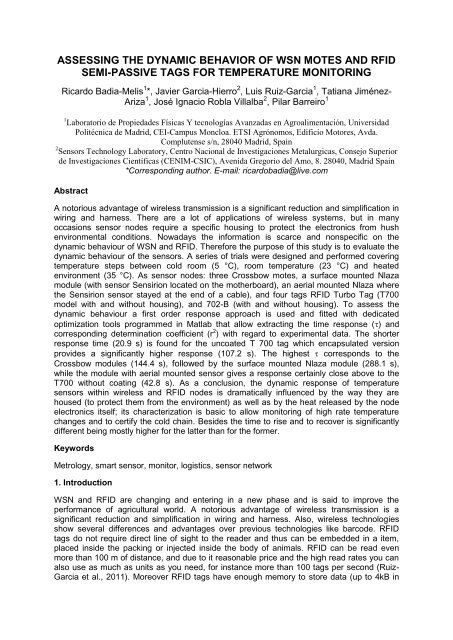ORAL - International Conference of Agricultural Engineering
ORAL - International Conference of Agricultural Engineering
ORAL - International Conference of Agricultural Engineering
You also want an ePaper? Increase the reach of your titles
YUMPU automatically turns print PDFs into web optimized ePapers that Google loves.
ASSESSING THE DYNAMIC BEHAVIOR OF WSN MOTES AND RFIDSEMI-PASSIVE TAGS FOR TEMPERATURE MONITORINGRicardo Badia-Melis 1 *, Javier Garcia-Hierro 2 , Luis Ruiz-Garcia 1 , Tatiana Jiménez-Ariza 1 , José Ignacio Robla Villalba 2 , Pilar Barreiro 11 Laboratorio de Propiedades Físicas Y tecnologías Avanzadas en Agroalimentación, UniversidadPolitécnica de Madrid, CEI-Campus Moncloa. ETSI Agrónomos, Edificio Motores, Avda.Complutense s/n, 28040 Madrid, Spain2 Sensors Technology Laboratory, Centro Nacional de Investigaciones Metalurgicas, Consejo Superiorde Investigaciones Científicas (CENIM-CSIC), Avenida Gregorio del Amo, 8. 28040, Madrid Spain*Corresponding author. E-mail: ricardobadia@live.comAbstractA notorious advantage <strong>of</strong> wireless transmission is a significant reduction and simplification inwiring and harness. There are a lot <strong>of</strong> applications <strong>of</strong> wireless systems, but in manyoccasions sensor nodes require a specific housing to protect the electronics from hushenvironmental conditions. Nowadays the information is scarce and nonspecific on thedynamic behaviour <strong>of</strong> WSN and RFID. Therefore the purpose <strong>of</strong> this study is to evaluate thedynamic behaviour <strong>of</strong> the sensors. A series <strong>of</strong> trials were designed and performed coveringtemperature steps between cold room (5 °C), room temperature (23 °C) and heatedenvironment (35 °C). As sensor nodes: three Crossbow motes, a surface mounted Nlazamodule (with sensor Sensirion located on the motherboard), an aerial mounted Nlaza wherethe Sensirion sensor stayed at the end <strong>of</strong> a cable), and four tags RFID Turbo Tag (T700model with and without housing), and 702-B (with and without housing). To assess thedynamic behaviour a first order response approach is used and fitted with dedicatedoptimization tools programmed in Matlab that allow extracting the time response () andcorresponding determination coefficient (r 2 ) with regard to experimental data. The shorterresponse time (20.9 s) is found for the uncoated T 700 tag which encapsulated versionprovides a significantly higher response (107.2 s). The highest corresponds to theCrossbow modules (144.4 s), followed by the surface mounted Nlaza module (288.1 s),while the module with aerial mounted sensor gives a response certainly close above to theT700 without coating (42.8 s). As a conclusion, the dynamic response <strong>of</strong> temperaturesensors within wireless and RFID nodes is dramatically influenced by the way they arehoused (to protect them from the environment) as well as by the heat released by the nodeelectronics itself; its characterization is basic to allow monitoring <strong>of</strong> high rate temperaturechanges and to certify the cold chain. Besides the time to rise and to recover is significantlydifferent being mostly higher for the latter than for the former.KeywordsMetrology, smart sensor, monitor, logistics, sensor network1. IntroductionWSN and RFID are changing and entering in a new phase and is said to improve theperformance <strong>of</strong> agricultural world. A notorious advantage <strong>of</strong> wireless transmission is asignificant reduction and simplification in wiring and harness. Also, wireless technologiesshow several differences and advantages over previous technologies like barcode. RFIDtags do not require direct line <strong>of</strong> sight to the reader and thus can be embedded in a item,placed inside the packing or injected inside the body <strong>of</strong> animals. RFID can be read evenmore than 100 m <strong>of</strong> distance, and due to it reasonable price and the high read rates you canalso use as much as units as you need, for instance more than 100 tags per second (Ruiz-Garcia et al., 2011). Moreover RFID tags have enough memory to store data (up to 4kB in
















